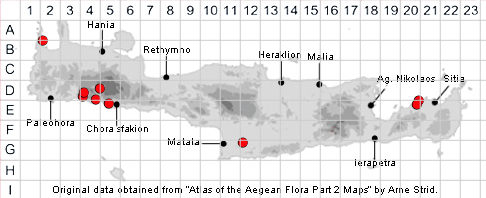
SPECIES DESCRIPTION
CAMPANULA LANCINIATA
Family and Genus:- See- CAMPANULACEAE
Common Names:- None
Homotypic Synonyms:- Campanula erucifolia
Meaning:- Campanula (L) Bell-like.
Laciniata (L) Jagged, fringed, slashed, with many flaps. Reference to
the leaves.
General description:- Pubescent, greenish perennial, with a very thick, wrinkled
(rugose) stock.
Stems:-
1) 20-60 cm, erect, simple or somewhat branched.
Leaves:-
1) Basal, c. 30 cm, ovate, margins laciniate-dentate.
2) Cauline, ovate, slightly laciniate or dentate, sessile to subsessile.
Flowers:-
1) Inflorescence, many-flowered.
2) Calyx-teeth:
a) triangular, acute, appendages ovate, rounded, deflexed, as long as the ovary.
3) Corolla, 40-50 mm wide, 3 times as long as the calyx-lobes, broadly
campanulate, velutinous, sky-blue often with a whitish centre.
a) lobes, broadly ovate, acute, erecto-patent.
4) Stigmas, 5.
5) Ovary, 5-locular.
Fruit:-
1) Capsule, 5-locular, dehiscing by basal valves or pores.
Key features:-
1) Capsule, dehiscing by basal valves or pores, rarely indehiscent.
2) Stigmas, 5.
3) Stems, erect or ascending.
4) Basal leaves, c. 30 cm, laciniata.
5) Ovary, 5-locular.
Habitat:- Crevices of vertical cliffs,often in gorges, occasionally among boulders at
the base of cliffs 0-700 m.
Distribution:- Endemic to the Aegean area, but rare throughout. Limited occurrence
on Crete.
Flowering time:- Apr-June
Photos by:- Fotis Samaritakis and Enda McMullen
Status:-
Conservation status (for threatened species): Rare (R) according to IUCN 1997
Protection status (for threatened species): Greek Presidential Decree 67/1981
